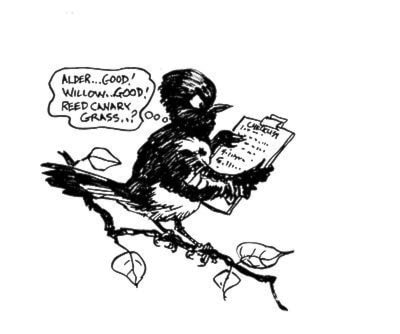By Tom Godin
Remember the canary in the coal mine story?
If I recall correctly, the idea was that miners would take a caged canary into the bowels of the earth with them and watch the bird as they went further and further into the mine. If the canary fell from its perch it meant that oxygen levels in the mine were dangerously low and the miners should turn back.
I have a similar story about determining the state of riparian habitat along Cariboo creeks, but in the case of my findings, birds are not dropping from perches – they are simply absent.
Riparian areas along creeks in the Cariboo come in two habitat types. There are the stretches where the stream flows quickly over a rocky bottom with spruce trees growing on the banks and very scant undergrowth beneath.
The other kind of habitat is where the creek is flowing much more slowly, meandering side to side in its bed like a giant, liquid snake. Here, the creek bottom is muddy and the banks are choked with willow growth, tall grasses and riparian-loving plants of all kinds.
It is this latter type of habitat that is so critical to a number of songbirds that migrate to our area to nest.
As you might imagine, creeks in the Cariboo have undergone a lot of changes brought about by humans and their activities. It stands to reason then that the riparian areas aren't always as I have described them above. The riparian habitats can range in quality from shorelines that are completely denuded to a few rare places where there have hardly been any degradation at all.
After spending several years living on Bradley Creek and watching the songbirds that gravitated to the various stretches of the creek, I came up with an avian-based habitat gauge that would indicate the state of the riparian situation in any given section of a creek.
Some songbirds are generalists in that they will thrive and nest in riparian spots that are somewhat degraded and it doesn't seem to matter if these riparian areas are found around a pond, a stream, a wet meadow or lake shore. Bird species that like this type of habitat are the Yellow Warbler, Lincoln Sparrow, Common Yellowthroat, MacGillivray's Warbler and Song Sparrow.
The second group of songbirds are those that need an intact understory along a creek, but this habitat doesn't have to be extensive and can even be interrupted or spotty, but it must be along a creek. These birds are the Gray Catbird, Veery, Northern Waterthrush, Wilson's Warbler and the Orange-crowned Warbler.
Then, there is a bird that stands alone in its stringent, riparian habitat requirements. This small bird demands not only rank willow growth right to the water's edge but those willows must be laced from top to bottom like an impenetrable jungle with reed canary grass, forbs and all manner of stream loving plants. Here, in this riparian jungle world, the small red and black Warbler, called the American Redstart, will nest.
If you happen to be a steward to riparian area like the latter type mentioned, your habitat has won the rare five-star rating of the pickiest of our riparian-loving songbirds. Cherish and safeguard what you have.
But don't despair if your habitat is not of such quality because habitat of this sort isn't that easy to find anymore. But make no mistake about the importance of even the lesser quality riparian areas. None of the birds mentioned above will nest at all if the riparian areas disappear.
Although this is no canary-in-the-coal-mine test I'm talking about, all riparian habitat is critical to songbird survival and whatever you can to preserve, even a vestige of the natural stream bank, is cause for celebration by bird and human alike.
